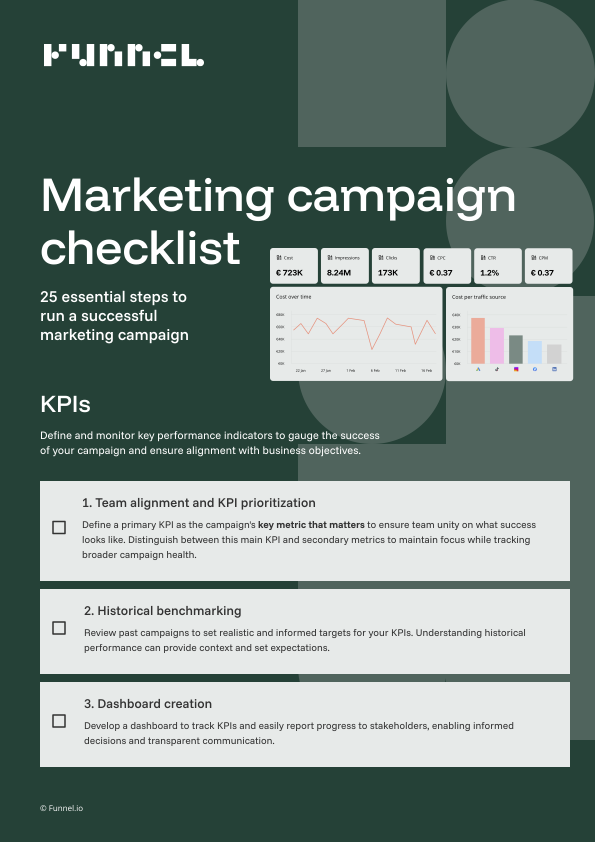-
 Written by Thomas Frenkiel
Written by Thomas FrenkielThomas has over 10 years of marketing experience. After working in media and SEO agencies for 8 years, he joined Funnel in 2022.
Planning and launching a marketing campaign is like embarking on a journey across a sea of opportunities. It's an intricate blend of art and science, creativity and analytics, planning and execution. At Funnel, we recognize the complexities of this journey and the necessity of being well-prepared for the challenges ahead.
A lot has been written already about campaigns. Other articles often underscore the importance of a methodical approach, focusing on clear goal-setting, cohesive team collaboration, and diligent performance tracking. Drawing from these insights and the collective wisdom of our own marketing department, we've created a 25-step marketing campaign checklist.
This checklist guides you through the entire campaign process, from the spark of an idea to the analysis of results. Whether you're a startup looking to make a splash or an established brand aiming to reinforce your presence, our checklist is your guide to navigate the complexities of digital marketing campaign.

Click the button below to download the marketing campaign checklist.
You can read through the 25 essential steps in this blog post, but we also offer a downloadable PDF and a Google Sheet template—both available for free.
The PDF is perfect for those who prefer a tangible guide they can download and reference at any moment. The Google Sheet template, on the other hand, is ideal for marketers who thrive on collaboration and real-time updates. It's a living document that you and your team can use to track progress, assign tasks, and ensure that every box is ticked.
Ready to begin? Let's dive into the 25 essential steps that will elevate your marketing campaign from concept to reality.
The marketing campaign checklist
With 25 essential steps for successful marketing campaigns.
Section 1: KPIs
Define and monitor key performance indicators to gauge the success of your campaign and ensure alignment with business objectives.
1. Team alignment and KPI prioritization
Success in marketing campaigns begins with clear alignment on the primary KPI — the key metric that matters. This KPI should directly reflect the campaign's main objective, such as lead generation or sales conversions. Ensuring everyone agrees on this KPI is crucial to avoid later disputes about campaign outcomes.
Alongside the primary KPI, identify secondary metrics for broader performance insights, keeping the primary goal in focus. This approach ensures clarity and unity, driving a targeted campaign strategy.
2. Historical benchmarking
If it's not the first time your company does a campaign like this one, make sure to look back at the previous campaigns. What were the results of these campaigns? Reviewing past campaigns can help you set realistic and informed targets for your KPIs.
3. Dashboard creation
Work with your data team or web analyst to develop a dashboard that tracks the progress of your KPIs. This is not only important for the team doing the campaign, it will also help and simplify reporting to stakeholders.
Section 2: Budget
Clearly allocate and communicate your financial resources to ensure the campaign runs smoothly without overspending.
4. Budget clarity
Determine the total budget allocated for the campaign. Define which channels will carry the campaign (paid, owned, earned, and shared) and ensure there's a clear understanding of the maximum spend for each channel. along with any flexibility.
Pro tip: When working on the budget for the campaign, try to also estimate the ROI (return on investment) and/or ROAS (return on ad spend). This helps in setting realistic expectations and ensures that your campaign is a strategic investment.
5. Campaign duration
Define the start and end dates of the campaign. This will influence budget pacing and allocation over time.
6. Budget breakdown
Allocate specific portions of the budget to:
- Each marketing channel (e.g., social media, PPC, email marketing).
- Creative production (e.g., graphic design, video production).
- Miscellaneous costs (e.g., tools, software, third-party services).
7. Stakeholder communication
Communicate the campaign's scope and expected impact to stakeholders, ensuring they understand how the budget facilitates these goals. Also make sure the budget breakdown is shared with all relevant stakeholders.
Section 3: Target audience, channels and targeting
Identify your ideal audience and strategically select the channels to reach them, ensuring your messaging is tailored and relevant.
8. Audience Definition
Clearly identify your target audience. Delve deep into demographics, behaviors, interests, and pain points to ensure precision in targeting.
Expert tip: Consider the customer journey. Are you trying to engage people who are already familiar with your brand or are you trying to reach a new audience? These kinds of questions will influence your choices down the road, such as messaging and design.
9. Channel selection
Choosing the right marketing channels is pivotal for your campaign's success. Consider where your audience spends their time and the nature of your product or service.
For visually appealing products like artwork, posters, or home decor, visual platforms such as Pinterest and Instagram are ideal. These channels showcase your products' aesthetic appeal and attract an audience that values design.
Conversely, for offerings like professional development courses, LinkedIn and Reddit are more suitable. These platforms cater to professionals seeking career growth and personal development.
10. Budget alignment
Ensure your channel choices align with your budget. It might be more strategic to focus on a few key channels, like Instagram or LinkedIn Ads, rather than spreading the budget thinly across multiple platforms.
11. Targeting within channels
For each selected channel, further segment your audience for tailored messaging. This could be based on factors like age groups, job roles, interests, or past interactions with your brand.
12. Content strategy
If your campaign involves content marketing, ensure you have a content calendar, and the content aligns with the campaign's objectives.
Section 4: Cross-team collaboration
Foster collaboration between departments to ensure a unified approach, leveraging insights from all teams involved.
13. Define the project team
Take some time to define the project team, the team lead, as well as any stakeholders outside the project team that must review and/or approve materials before they launch. Also, clearly define the roles, responsibilities and deliverables for each member of the project team.
14. Stakeholder communication
As soon as the campaign details are finalized, proactively engage with relevant stakeholders. This could be the sales team, customer support, or other departments impacted by the campaign.
15. Expectation management
If your campaign aims to generate leads that sales need to work with, provide them with insights on target audiences, campaign objectives, messaging, and a preview of the landing page. Clarify the type and volume of leads the campaign aims to generate so they can be adequately prepared.
If your campaign aims to generate direct sales instead of leads, make sure you have enough products in stock to meet higher demand.
16. Feedback mechanisms
Schedule periodic meetings with impacted teams and establish a structured system for continuous feedback, enabling real-time campaign adjustments based on team insights.
Section 5: Design
Ensure your campaign visuals and messaging resonate cohesively across all touchpoints to captivate and engage your audience.
17. Ad creation
Ensure ads are designed in the appropriate formats and sizes for each platform. They should be visually appealing and ready well in advance of the campaign launch. Keep in mind that some channels (like social media ads) require more copy in addition to the ad creative like captions, call-to-action text, etc.
18. Visual consistency
Maintain a uniform look and feel across all campaign touchpoints, from ads to landing pages, ensuring that color schemes, branding, and visual elements align seamlessly. For example, when we do a campaign, all elements of the campaign must also adhere to the Funnel brand standards.
19. Messaging consistency
It's crucial for all touchpoints to work together seamlessly. Paid ads should be complemented by social organic and content marketing efforts. The landing page should effectively persuade the user to take action, while sales reps should be able to close the deal successfully. While it may not be an easy task, ensuring that all touchpoints are aligned can significantly improve the overall effectiveness of a marketing campaign.
20. Landing page UX
- Responsiveness: Ensure the landing page is mobile-friendly, catering to users across devices.
- Load time: Optimize for quick load times to reduce bounce rates.
- Intuitive navigation: The user journey should be straightforward, guiding visitors effortlessly toward the desired action.
21. Call to action (CTA)
Design a clear CTA that stands out and compels users to take action, such as signing up or making a purchase.
Section 6: Tracking
Implement precise tracking mechanisms to measure campaign performance, enabling data-driven decisions and optimizations.
22. UTM tagging
Implement UTM tags for all campaign URLs to accurately track the source, medium, and campaign performance in your analytics tool.
23. Event tracking
Set up tracking for key interactions on your landing page. This includes tracking button clicks, downloads, and sales or conversions.
24. A/B Testing
Consider testing different ad visuals, landing page layouts, and CTAs to identify the most effective combinations.
Expert tip: When conducting A/B tests, it is important to test only one variable at a time to accurately determine what factors impact performance.
25. Tracking pixels
To retarget visitors who landed on your landing page, it's vital to ensure that the pixels are installed correctly. Once implemented, you can create retargeting lists based on user behavior such as those who visited the page but didn't convert. This will enable you to serve them tailored ads that are more likely to lead to a conversion.
That's it! We hope the checklist will help marketing teams navigate the complexities of modern digital campaigns.
About this checklist
We've distilled our collective expertise into this marketing campaign planning checklist to help you refine your marketing strategy and ensure your campaigns are set up for success. Our team, comprising veterans from various marketing battlegrounds, has come together to pool their knowledge into this resource. We've run campaigns of all scales, from targeted bursts to sustained always-on strategies, and now we're sharing our playbook with you.
FAQ
What are “always-on" campaigns?
Always-on campaigns refer to continuous marketing efforts that maintain a consistent presence for your brand, rather than being limited to specific promotional periods. They help in building sustained brand awareness and keeping your audience engaged over time.
Always on marketing campaigns play an important role in the digital marketing strategy of successful brands.
How do we measure campaign success?
Measure campaign success by aligning your KPIs—like click-through rates, conversion rates, engagement levels, and ROI—with your initial campaign goals. This will be different per campaign. A brand campaign will be launched to raise brand awareness with a specific audience, while a Black Friday campaign will focus on getting as many people to convert as possible. Regular analysis of these metrics will indicate the campaign's performance and areas for improvement.
When should we start preparing our campaign?
For a large, successful marketing campaign, begin planning 3 to 6 months in advance. Smaller campaigns may require 1 to 2 months of prep time. Early planning allows for thorough market research, creative development, and setting up necessary tracking mechanisms.
Related reading: The formula for a winning full-funnel marketing strategy
-
 Written by Thomas Frenkiel
Written by Thomas FrenkielThomas has over 10 years of marketing experience. After working in media and SEO agencies for 8 years, he joined Funnel in 2022.
